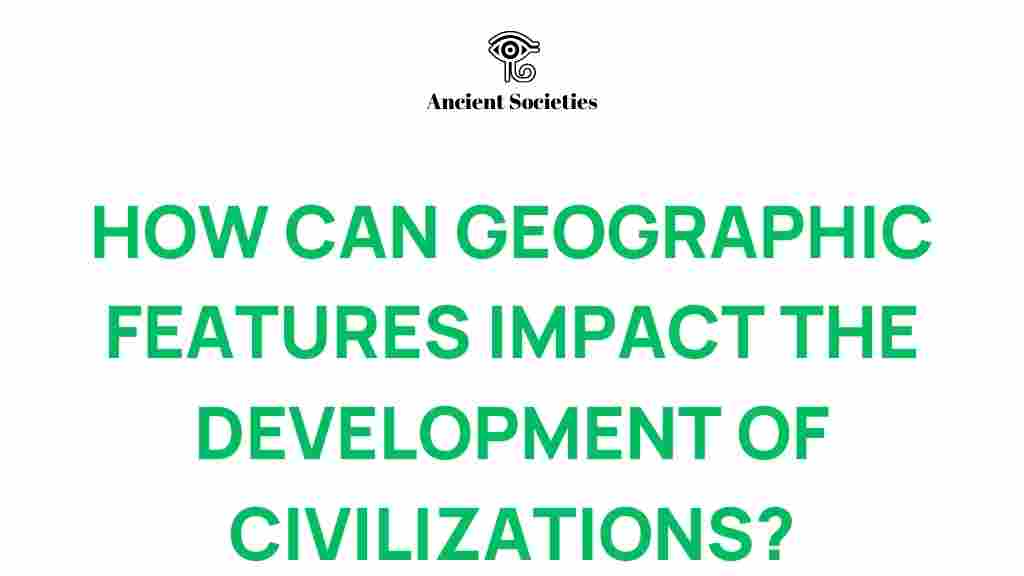Unveiling the Hidden Forces: How Geography Shapes Civilizations
Geography has long been a silent architect of human history, influencing the development of civilizations in profound ways. From climate to trade routes, the natural environment has shaped societies, cultures, and economies. Understanding the interplay between geography and civilizations helps illuminate the pathways of cultural evolution and societal growth. In this article, we will explore how various geographical elements contribute to the development of civilizations, shaping their historical impact and cultural narratives.
The Role of Geography in Civilizational Development
Geography affects civilizations in multiple dimensions. Here are some critical geographical factors that have historically influenced societal structures:
- Natural Resources: The availability of essential resources like water, minerals, and fertile land plays a crucial role in determining where civilizations can thrive.
- Climate: Climate conditions dictate agricultural practices, settlement patterns, and even trade.
- Trade Routes: Geographic features often dictate the formation of trade routes, enabling communication and cultural exchange.
- Topography: Mountains, rivers, and plains can either hinder or facilitate movement and interaction between groups.
Natural Resources: The Heartbeat of Civilizations
Natural resources are foundational to any civilization’s economy and growth. Regions rich in resources like timber, minerals, and arable land often see significant development. For instance, the ancient Egyptians thrived along the Nile River, whose fertile banks provided sustenance and stability.
The availability of resources leads to:
- **Economic Prosperity:** Civilizations with abundant resources can engage in trade, leading to wealth accumulation.
- **Cultural Flourishing:** Resources support arts, education, and technological advancements.
- **Population Growth:** A stable food supply encourages larger populations and urbanization.
Climate: The Silent Influencer
The climate of a region significantly shapes its agriculture and lifestyle. For example, temperate climates with moderate rainfall support diverse agriculture, while arid regions may lead to nomadic lifestyles. The climate has historically dictated:
- **Agricultural Practices:** Different crops thrive in different climates, influencing diet and trade.
- **Settlement Patterns:** Harsh climates can limit where people choose to settle, leading to concentrated populations in more hospitable areas.
Many civilizations, such as the Maya and the Incas, adapted their agricultural practices to their unique climatic conditions, showcasing human resilience and innovation.
Trade Routes: The Veins of Civilization
Trade routes are vital for the exchange of goods, ideas, and cultures. Geography heavily influences the development of these routes, as they often follow natural pathways such as rivers and coastlines. Key trade routes like the Silk Road connected distant civilizations, facilitating cultural evolution and economic growth.
Trade routes contribute to civilization development through:
- **Cultural Exchange:** Different cultures interact, leading to the sharing of ideas, beliefs, and technologies.
- **Economic Interdependence:** Civilizations become economically tied, fostering cooperation and conflict.
- **Expansion of Influence:** Control over trade routes can enhance a civilization’s power and reach.
Topography: The Physical Layout of Societies
The physical features of a region significantly affect its societal development. Mountains can provide protection but may isolate communities. Conversely, plains facilitate agriculture and trade. Understanding topography helps explain the rise and fall of civilizations.
For instance, the Fertile Crescent facilitated early agriculture due to its rich soil and favorable climate, while the Himalayan mountains shaped the cultures of the communities that lived in their shadows.
Historical Impact of Geography on Civilizations
The historical impact of geography on civilizations is evident through various case studies. Let’s explore a few notable examples:
- The Roman Empire: Its strategic location around the Mediterranean allowed for trade and military expansion, leading to its vast influence across Europe, North Africa, and the Middle East.
- The Chinese Dynasties: The geography of China, with its rivers and mountains, shaped dynastic boundaries and cultural practices, influencing everything from agriculture to philosophy.
- The Aztecs: Their civilization thrived in the Valley of Mexico, where the unique geography provided resources and strategic advantages against rivals.
Societal Growth and Cultural Evolution
As we delve deeper into how geography drives societal growth, we must consider the long-term effects of environmental factors on cultural evolution. Each civilization’s unique geographical context has led to distinct social structures, belief systems, and innovations.
Key points include:
- **Adaptation:** Civilizations often adapt their cultural practices to their geographical realities, such as the Inuit’s use of igloos and seals for survival in Arctic regions.
- **Innovation:** Geographic challenges spur innovations, from irrigation systems in arid regions to architectural advancements in earthquake-prone areas.
- **Identity Formation:** Geography contributes to the cultural identity of a civilization, influencing language, traditions, and social norms.
Challenges and Troubleshooting in Understanding Geography’s Role
While the influence of geography on civilizations is significant, it can also present challenges in understanding historical contexts. Here are some common issues and how to address them:
- Oversimplification: Avoid attributing a civilization’s success or failure solely to geography. Consider a combination of factors, including politics and economics.
- Dynamic Changes: Remember that geography is not static; natural disasters and climate changes can reshape societies dramatically.
- Cultural Superiority: Be cautious of viewing some civilizations as superior due to geographical advantages; every culture has unique strengths.
For further reading on the complexities of geography’s impact on civilizations, check out this external resource that dives deeper into historical studies.
Conclusion: The Intertwined Fates of Geography and Civilization
In conclusion, geography serves as a powerful force that shapes civilizations in multifaceted ways. From natural resources and climate to trade routes and topography, these elements influence the development, cultural evolution, and historical impact of societies. Understanding these connections provides valuable insights into the past and helps us navigate contemporary global dynamics.
As we continue to study the interplay between geography and civilizations, we can better appreciate the rich tapestry of human history. To explore more about the relationship between geography and civilizations, visit this internal link for additional articles and insights.
Ultimately, the hidden forces of geography remind us that our environment plays a crucial role in shaping who we are and how we connect with one another throughout history.
This article is in the category History and created by AncientSocieties Team
